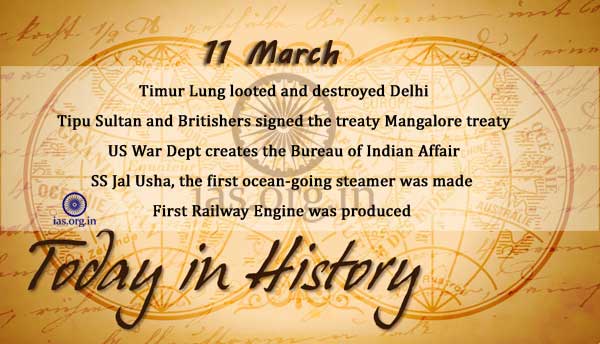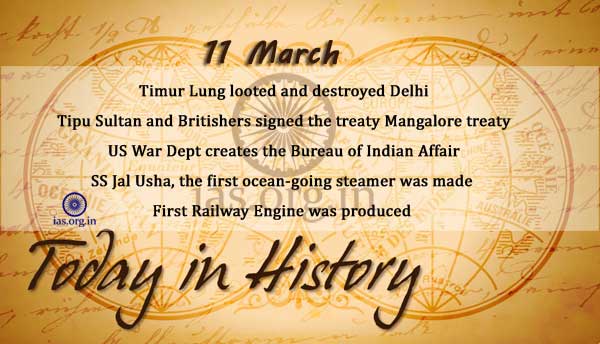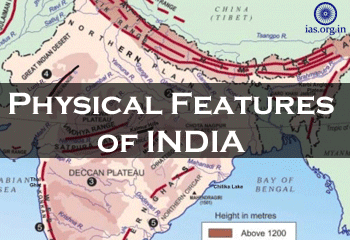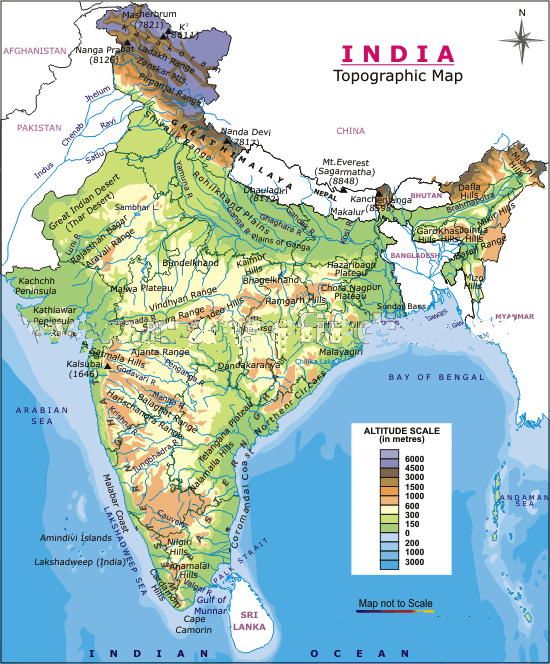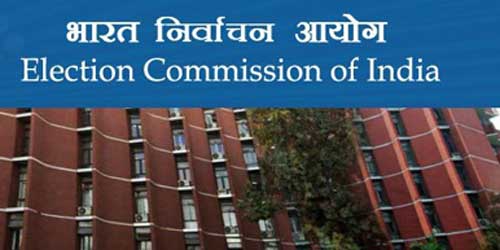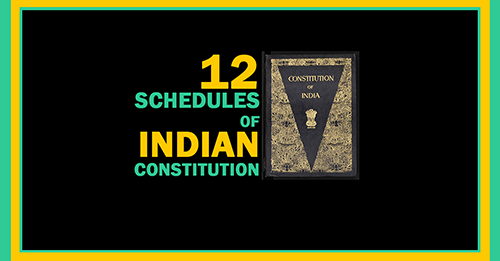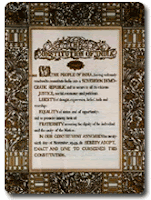Name the physiographic units of India and briefly explain their formation.
I.Introduction: The Indian subcontinent is characterized by the diversified physical features. They exhibit striking contrasts in structure, altitude, climate etc.
II. Physiographic divisions: Physical features of India may be divided into four physiographic units.
They are
1. The Himalayas and their associated mountain range.
2. The Indo-Gangetic plains
3. The peninsular plateau.
4. The coastal plains.
1. Formation of the Himalayas:
a. According to the Geologists, during Mesozoic times, the entire Himalayan area was occupied by a great Geosyncline called “Tethys sea”.
b. Angaraland was the land mass to the North of Tethys Sea. Gondwana land which contained the present peninsula was to the south of the Tethys Sea.
c. In the course of time, these two land masses split up and began to move apart.
d. Then the weaker Tethys Sea got compressed and buckled up.
e. After some million years due to immense compressional forces, the sediments deposited in the Tethys Sea were folded to acquire the present form of Himalayan Mountains.
2. Formation of Indo Gangetic plains:
a. In the wake of the Himalayan uplift, a ‘fore deep’ was formed in the intervening space between the peninsular plateau and the Himalayan Mountains.
b. Then an immense amount of Alluvium was deposited in this depression by the Himalayan Rivers. Thus, it became the largest alluvial plain in the world.
3. Formation of peninsular Plateau:
a. According to Geologists, it was a part of The Gondwana land.
b. It was a block of old crystal rocks lifted above the sea level in the pre-Cambrian times, and never submerged again.
4. Formation of coastal plains: Were formed by the peninsular rivers.
What are the parallel ranges of the Himalayas? Explain.
I. Introduction: The Himalayas form India’s northern frontier from Jammu and Kashmir to Arunachal Pradesh with a distance of 2400 km and a width of 500 km.
II. Kinds of parallel ranges of Himalayas: The
Himalayas comprise three parallel ranges with deep valleys and extensive plateaus. They are:
1. The Himadri (The greater the Himalayas)
2. The Himachal or lesser the Himalayas
3. The Siwaliks or outer the Himalayas
The Himadri or Greater Himalayas:
a. This is the highest loftiest and most continuous range with an average elevation of about 6100 mts.
b. It has the world’s highest and prominent peaks such as Mt. Everest, Kanchenjunga etc.
c. It is formidable and snow bound through out the year and found with a number of glaciers.
d. It is mainly composed of crystalline and metamorphic rocks.
The Himachal range:
a. This is a most intricate and rugged mountain system.
b. It is to the south of the Himadri range with an altitude of 1000- 4500 mts.
c. Its width varies between 50 and 80 kms.
d. The most important and longest range in the Himachal is the Pir Pan Jal range of Kashmir.
e. Kashmir valley lies between Himadri and Pirpanjal range.
f. It has beautiful Kulu and Kangra valleys.
g. Many hill stations like Simla, Mussoorie, Nainital etc are situated in this range.
The Siwalikhs:
a. It is the southern most range of the Himalayas.
b. It extends from Jammu and Kashmir to Arunachal Pradesh.
c. The Siwaliks in Jammu region are called Jammu hills and in Arunachal Pradesh as Mishi hills.
d. The width of this range varies between 50 km in Himachal Pradesh and 15 km in Arunachal Pradesh.
e. Its average height ranges from 600 to 1500 mts.
f. These are backed by The ‘Duns’ and are covered with thick tropical deciduous forests.
Describe the importance of Himalayas.
A. I. Introduction: The Himalayas form India’s northern frontier from Jammu and Kashmir to Arunachal Pradesh covering a distance of about 2400 km and with a width of 200 to 500 km.
II. Importance of the Himalayas:
Barriers: The Himalayas act like barriers protecting the great plains of India from the cold winds of central Asia during winter. They also acted as impenetrable borders protecting the country from foreign invasions
Cause rains: The Himalayas are responsible for causing rainfall in the plains during summer and ultimately to have a monsoon type of climate in the country.
The Perennial flow of water: Rivers originate in the glaciers of these mountains and cause the perennial flow of water. These lives contributed to the economic development of the Great Plains.
Scenic beauty: The Himalayas are known for beautiful valleys like Kashmir Kulu, Kangra etc and hill stations. These valleys and hill stations attract tourist from all over the world and earn foreign exchange for the country.
Horticulture: Himalayan valleys are known for the cultivation of fruits like Apples.
Vegetation: Alphine vegetation is an important contribution to the forest economy.
The gaps in the mountain ranges of the Himalayas called passes- like Khyber, Bolan, permitted a great exchange of culture and commerce with neighbouring countries.
III. Conclusion: Thus, there are many advantages of the Himalayas to India.
What is a pass? Give examples.
1. The gaps in the Himalayan mountain ranges which provide natural routes across them are called passes.
2. The important passes in the Himalayan mountain ranges are Khyber, Bolan, Karakoram, Nathula, and Bomidila etc.
What is ‘DUN’? Give examples from the Himalayan region.
1. The Siwalik Mountains are backed by a discontinued series of narrow longitudinal flat-bottomed strike valleys. These valleys are called as ‘Duns’
2. Dehra Dun and Patli Dun in Uttaranchal and Kotli Dun in Jammu are the examples of prominent “Dun Valleys”.
Name the important peaks of Himalayas.
The Himadri range has world’s highest and prominent peaks. The Important peaks of The Himalayas are
1. Mt. Everest (8848 mts)
2. Kanchenjunga (8598 mts)
3. Makalu(8481 mts)
4. Dhaulagiri (8177 mts)
5. Manaslu (8156 mts)
6. Chooyu (8153 mts)
7. Nanga Prabhath ( 8126 mts)
8. Annapurna (8078 mts)
What is plain? Describe the surface differences recognized with the geomorphology of Great Plains.
I. Introduction: The land surface is not the same everywhere. There are various land forms i.e. mountains, Plateaus, and plains.
II. Meaning of plain: The material eroded and transported by rivers is deposited at suitable places and thus, plains are formed. A fertile land with the level surface, gentle, slope and with heights far less than a plateau is called a plain.
III. Surface differences of Great plains: There are four important surface differences recognized with the Geomorphology of great plains. They are Babar, Terai, Bhanger, Khadar Babar: The Himalayan rives deposit gravel and unassorted sediments along the foot of the Siwaliks. This pebble-studded zone of porous beds is known as Babar. It forms a narrow belt, only 8 to 16 km width in the northern boundary of Punjab, Haryana, and Uttar Pradesh.
Terai : Many small Himalayan rivers flow underground through Bhabar zone and reemerge on the surface creating 15-30 kms wide marshy tract called ‘Terai’
Bhangar : the older alluvium of the floodplain is called Bhangar’.
Khadar : The never alluvium of the floodplain is called ‘Khadar’. This zone is found with excessive dampness with a th
ick growth of forest and a variety of wildlife.
Also, Read: Wildlife Sanctuaries in India
Compare and contrast the geomorphologic features between Malwa plateau and Deccan Plateau.
A. Introduction: The peninsular plateau is one of the physiographic units of India. It is broadly divided into Malwa Plateau and Deccan Plateau.
| Malwa Plateau |
Deccan plateau |
| 1. It is bounded by the Aravallis on the northwest and the vindhyas on the south. |
1. It is bounded by the satpura range on thenorth, western ghats on the west and eastern |
| 2. Its extensions are known as Bundalkhand and Bhaghalkh and uplands in Uttar
Pradesh and in as Chota Nagpur plateau in
Jharkand. |
2. Its extensions are Maharashtra Plateau onthe north and north west. Andhra plateau on
the south west and Karnataka plateau
on the south. |
| 3. In its interior parts its surface isflat with isolated hillocks. |
3. Its table land consists of horizontallyarranged lava sheets |
| 4. No Deltas are found here |
4. It has many deltas. |
| 5. It occupies lesser area |
5. It occupies larger area. |
| 6. It is not much suitable for cropcultivation. |
6. It is suitable for crop cultivation |
| 7. It tilts towards the Gangetic plain. |
7. It tilts towards the east. |
| 8. It has less elevation than theDeccan plateau. |
8. It has varied elevation from 900mts in the west to 300 mts on the east. |
Distinguish the differences in physiography of Western ghats and Eastern ghats.
A. I. Introduction: Deccan plateau is bounded by the western ghats on the west and Eastern ghats on the east. East western ghats and Eastern ghats meet at Nilgiri hills.
| Western ghats |
Eastern ghats |
| 1. They start from Khandesh in Maharastraand end at Kanyakumari in Tamil Nadu. |
1. They start from the hills of ChotanagpurPlateau in Jharkhand and run upto Nilgiris
in Tamil Nadu. |
| 2. They are to the western side of theDeccan Plateau. |
2. They are to the eastern side of theDeccan Plateau. |
| 3. They are continuous chain of hills runningin a north-south with some gaps like palghat,
Thal ghat and Bhorghat gaps. |
3. They are represented by irregularline of hills. |
| 4. They are very close to the coast keepinga narrow coastal plain. |
4. They are far away from the coast keepingbroad coastal plain. |
| 5. They have structural unity and awell defined lay out. |
5. They do not have any structural unityand a well defined lay out. |
| 6. The northern part of western ghats is known as Sahyadri. Annamalai hills and cardamom hills arethe southern parts. |
6. They have local names are called as Simahachalam in Visakhapatnam, Papi Kondalu in Wast Godavari etc. Nallamalai in Kurnool, Pachamalai and in Tamil Nadu. |
| 7. Anaimudi in Kerala the highest peak. |
7. The highest peak of Eastern ghats is found in chintapalli village of Vishakapatnam |
| 8. There are dense forests. |
8. Forest all not that dense as that to western ghats. |
Compare the coastal plains of east and west.
| East coastal plain |
West coastal plain |
| 1. They stretch from Bengal to KanyaKumari. |
1. They strech from Rann of Kutch tokanyakumari. |
| 2. They are wider and flat. |
2. They are narrow and uneven. |
| 3. They are situated between TheEastern Ghats and the Bay of Bengal. |
3. They are situated between the westernGhats and the Arabian sea. |
| 4. Well watered deltas are found. |
4. Long bars and lagoons are found.Deltas are not found. |
| 5. Alluvial plains are formed by Mahanadi,Krishna, Godavari and Cauvery rivers. |
5. Alluvial plains are formed by Narmada,Tapti, Sabarmati and Mahi rivers. These plains
are found to the north of west
coastal plains. |
| 6. Irrigational facilities are well developed. |
6. This region has less developedirrigational facilities. |
Facts File:
The Himalayas are the young folded mountains.
The Himalayas were once occupied by the sea Tethys.
The Himalayas form India’s northern frontier from Jammu and Kashmir to Arunachal Pradesh.
The longitudinal extent of Himalayas is 5 lakh sq.km.
Greater Himalayas are also known as The Himadri.
K2 mountain peak is in Trans-Himalayan zone.
The highest mountain peak of The Himalayas in India is Kanchanjunga.
Pamir plateau is located in Trans-Himalayan zone.
The longitudinal extent of The great plains in India is 7 lakhs sq.km
The younger Alluvium is known as Khader.
Terai is a wide marshy track.
Bundelkhand upland is an extension of Malwa plateau.
Peninsular plateau is slightly tilting towards The east.
The highest peak in peninsular plateau is Annaimudi.
The Deccan plateau is bounded on north by sathpura range.
Narmada river flows through a rift valley.
Alakananda and Bhagirathi head streams formed the main stream of ganga.
The world’s highest and prominent peaks are found in Himadri range.
The most important Himachal range is Himachal.
South-west world extension of pirpanjal is called Dhaula Dhar range.
The world’s second highest peak is K2.
The longest glacier is Siachin.
The world’s highest table land is Pamir plateau.
Luni basin is found in Rajasthan plain.
Guru sikhar peak is situated in the Aravalli hills.
The important summer resort in M.P is pachmarhi.
The highest peak of the Nigiris is Doda betta.
The Ganga enters Bangladesh and then it is called Padma
The largest peninsular rivers Godavari.
Godavari joins Bay of Bengal near Rajamundary in A.P
| A |
B |
| 1. Manasarover2. older alluvium
3. Marshy tract
4. Pirpanjal range
5. West flowing river |
a. Brahmaputrab. Bhanger
c. Terai
d. Himachal
e. Tapti |
Have a look at:
Indian River Systems
Plateau
Rivers World
Monsoon, Floods, and Droughts


